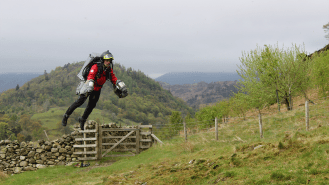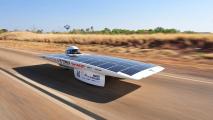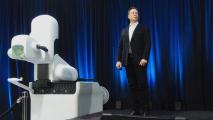Watch: Medic in jet suit reaches mountain top in 3.5 minutes
A paramedic in a jet suit reached the top of a UK mountain in just 3.5 minutes — about an hour faster than he would’ve been able to climb it on foot — demonstrating how the futuristic tech could be used to save lives in an emergency.
The challenge: Getting a paramedic to the scene of an emergency as quickly as possible can be the difference between life and death — a person can bleed out in just 2-5 minutes, and if a stopped heart isn’t restarted within 9 minutes, severe brain damage is likely.
The medic quickly reached the mountain’s peak in weather conditions a helicopter couldn’t handle.
In an urban setting, paramedics can hop in an ambulance and speed down a road to someone in need, but the situation is more complicated in rural or remote areas, such as Helvellyn, a British mountain that’s popular with hikers.
The 3,100-foot-tall mountain can take more than an hour to climb, so if someone on it needs help, the fastest way for paramedics to reach them is via helicopter. If the weather’s bad, though, a helicopter can’t fly — meaning medics have to waste precious time climbing on foot.
Jet suit up: In 2020, the Great North Air Ambulance Service (GNAAS), a UK charity, began working with aerospace company Gravity Industries to test an alternative transportation method for its paramedics: jet suits.
Gravity has been building and testing jet suits since 2017. The current design includes five jet engines — two strapped to each arm and one worn in a backpack — which create enough thrust to propel a person through the air at up to 85 miles per hour.
“The success of this next stage of the jet suit trial is a great step towards helping us reach more patients.”
Andy Mawson
After just six days of training, GNAAS paramedic Jamie Walsh donned a Gravity jet suit for a trial mission at Helvellyn. In just 3.5 minutes, he was able to travel 1.2 miles to the mountain’s peak — all in weather conditions a helicopter couldn’t handle.
“We are delighted that today’s trial has demonstrated not only the speed with which we can train capable candidates but also the ground-breaking speed of the response in a first mission in Helvellyn,” said Richard Browning, Gravity’s founder and chief test pilot.
“Patient care is at the forefront of everything we do at GNAAS, and the success of this next stage of the jet suit trial is a great step towards helping us reach more patients,” added Andy Mawson, director of operations at GNAAS.
The limitations: While a jet suit can get a paramedic to a person in need, it can’t get that person to a hospital, so GNAAS is never going to replace its medevac helicopters with Gravity’s mini jet suits.
There are also going to be times when it wouldn’t be safe for a helicopter or a jet suit to fly, but for those days when the weather is like it was during the trial, a paramedic could fly up to and stabilize an injured person and then wait with them for a helicopter or ground rescue to arrive.
Looking ahead: GNAAS plans to put the jet suit to the test in the summer of 2022, using it to send paramedics to people who are actually in need of help.
“Jamie’s flight is a crucial milestone … however, there is still lots to be done,” said Mawson. “We will now be looking at completing the training, as well as development of the medical equipment and ongoing development of communications and navigations.”
We’d love to hear from you! If you have a comment about this article or if you have a tip for a future Freethink story, please email us at [email protected].






